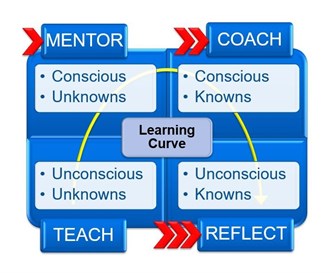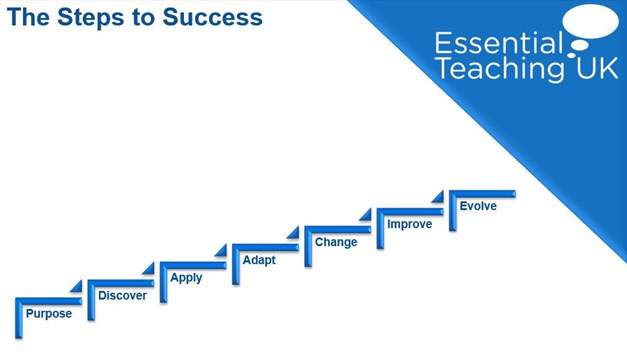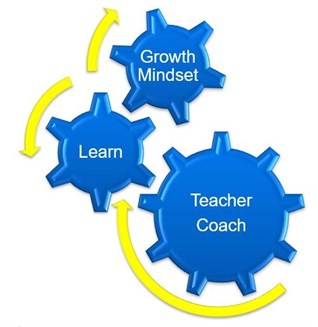Coaching for education to inspire, motivate and raise the aspirations of your learners
It’s a lot easier for a learner if they understand why they are learning something. It’s also great if they know what they want to do as a career because then it’s easier for them to learn.
Gavin Lumsden: Coaching For Education on SoundCloud.
Often students are trying to understand why they need to learn something, and that is something that we get all our trainee teachers to appreciate. It is also why we get them to look at the 10 principles of pedagogy, as opposed to what it is they’ve got to learn, because the ‘what’ is all great, but you really need to understand the ‘why’.
That’s why the purpose of what you’re learning really comes into place; allowing learners to discover new knowledge, apply it and adapt that knowledge. Once they have that concrete knowledge base, it’s about getting them to change and improve their knowledge, and then getting them to evolve it.
There are different stages of the why:
- What is the purpose
- Getting them to discover, learn and dive into the content
- Getting them to apply and adapt it
- Getting them to change, improve and evolve their learning to cement that learning
Coaching versus mentoring

Learning Curve
What is the difference between teaching, coaching and mentoring? There is no difference; I know that sounds like I am going mad, but there is no difference for the learner. Instead, it is how the teacher/coach/ mentor interacts with the learner – and what changes that, is what the learner knows.
If we look at the Johari Window model you can imagine a square with four panes of glass inside it. The bottom left-hand corner is about the unconscious unknowns, so people who don’t know what they don’t know. In that bottom corner is where teaching is required – so if you don’t know what you don’t know, you need to be told and you need to be taught, educated and instructed.
You then have the top left-hand corner, which is when the learner is now conscious of what they don’t know and the unknown – the conscious unknowns. It’s now that a learner starts to discover. If you think about the Steps to Success (see the below diagram) and why we learn (purpose; discover; apply; adapt; change; improve and evolve), we’ve gone from purpose to discover, and this is the point where the learners are hopefully looking for more knowledge and foundations to the learning.
This is where a mentor comes in – although I feel we need to get away from the fact that we are calling them mentors and think of it as a mode that the teacher is in, or think of it as a mode the facilitator is in. If I had my own way, I would get rid of the whole word ‘teaching’, ‘mentoring’ and ‘coaching’ because they all have one thing in common and that is to change behaviour and ensure learning takes place. A mentor is a mode the teacher is in and the difference there is that when you are teaching you are pushing them to find more knowledge, and when you are mentoring them you are pulling them towards new knowledge, so you are showing them a way. As a mentor you are a subject mentor expert, you’ve got that prior knowledge and expertise and you are pulling the learner into that knowledge.

The Steps to Success
That brings us to the top right-hand corner, which is where the learner is now conscious of what they know – conscious knowns – and that is where coaching comes in. At this point you are not pushing or pulling them, you are running ahead of them and waving at them. Because now they know what they know, they get to choose the path of how they get to you. So again, it’s not about being a coach, it’s about being in that mode of being a coach – so giving hot feedback, using open questions, making the learner take ownership of their learning, choosing the path they want to take and developing themselves along the way, as opposed to you showing them what to look at as they go through. There is a quote that I always use by Alexandra K.Trenfor and that is: “The best teachers are those who show you where to look but don’t tell you what to see.” That’s what the coach does – they show you were to look but not where to see. That’s the learner taking ownership and that’s the top part of the coaching for education model.
The bottom right-hand corner is your unknown knowns, so the stuff you’ve forgotten. That’s where reflective practice comes in – if ever there is a need to know why we do reflective practice, it’s because we forget things. 'Stuff' becomes unconscious and reflection ensures we can align it to things we are doing. Those four sections follow the learning curve, which is ultimately how all learning takes place.
Facilitating learning within the classroom
Learners do not tend to experience the change – it just happens. It’s not modular in that fact, it’s very much the facilitator using all of those skills at different times of the programme, lesson and the course. You could find a teacher using the teach mode and mentor mode in the same lesson, because it’s not rigid in the fact that everybody knows everything and because there may be new knowledge in that lesson.
There also may be parts of old knowledge that the teacher can use to scaffold new knowledge onto. It is very much like having a white board with a blue, red and green pen where you are choosing which pen to use for that element of the learning. By having this skillset in your back pocket, it just takes the facilitator to be aware to do an initial assessment at the start of the course, ask questions at the start of a new session, set them research tasks which enable them to go and do the learning.
If you have different learners in the class, you can teach and empower them in different ways. In other words, it’s very much part of the differentiation within the class, so if you have learners that need to be taught then do so. Likewise, if you have people who do know what they don’t know, you can get them to share and discuss that. You may also have learners who are ahead and have prior knowledge, meaning you can empower them and develop their growth mindset in taking ownership themselves by doing their own research and developing themselves further.

Growth Mindset, Learn, Teacher Coach
Local Network Group event (June 2019)
We were very lucky that we had an amazing venue for the first SET Local Network Group in Portsmouth, held at the Spinnaker Tower. Around 50 SET members and non members attended, made up of a variety of people from secondary, FE, teachers, trainers, and even sports coaches. What I got from it, interestingly, because we had that blend of different teachers and coaches, is that all of them had similarities.
They both saw the benefits of understanding that when learners are unconscious of the unknowns right through to knowing what they know and that ability to go from teacher to coach to facilitate a permanent change in behaviour and learning. It didn’t matter who was in the classroom, they were all brought together by this process of ensuring that learning took place and it was a good learning environment for their learners. And certainly, at the end the feedback was good and they all enjoyed the content and got a lot out of it.
My background into education
I became a teacher back in 2009 when I completed my Qualified Teacher Learning Status (QTLS) with SET, which set the foundations for me into how to facilitate learning. At the time I was teaching in the Royal Navy and had the opportunity to complete my Certificate of Education at Farnborough College, University of Surrey. My academic background was fairly fractured with three GSCEs, having completed my English GCSE in 2007, bringing that number up to four. I then found out several things about myself – one that I was dyslexic, and secondly, that I really did like teaching. As a result, I completed a degree in education in 2010/11. Interestingly, it was at this point that the coaching for education piece came in – I excelled at sport as a child and at being coached and being mentored, but I didn’t excel at being taught or being academic. Of course, in those days in 1994/95 I was just labelled as being not very academic and just sporty. This is one of the reasons I am a massive advocate of the fact that actually we can change students’ viewpoint to education when they take ownership and when we take some of the skillset from being coached to the academic world.
This is what happened during my degree – I was taught, because there were things I didn’t know – but my two tutors were great as they mentored and coached me, which then made me take ownership and be better at what I was doing and developed my love for education and passion to learn.
Article as told to SET's Online Editor, Julia Faulks







